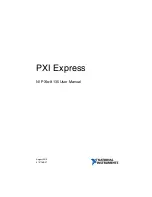
© National Instruments
|
1-5
LabWindows/CVI is an interactive ANSI C programming environment designed for building
virtual instrument applications. LabWindows/CVI delivers a drag-and-drop editor for building
user interfaces, a complete ANSI C environment for building your test program logic, and a
collection of automated code generation tools, as well as utilities for building automated test
systems, monitoring applications, or laboratory experiments. For more information visit
ni.com/lwcvi
.
NI-DAQmx provides an extensive library of functions that you can call from your application
development environment or interactive environment such as NI Signal Express. These
functions provide an intuitive API for National Instruments’ multifunction DAQ products.
Features available include analog input (A/D conversion), buffered data acquisition (high-speed
A/D conversion), analog output (D/A conversion), waveform generation, digital I/O,
counter/timer operations, SCXI signal conditioning, RTSI or PXI Express synchronization,
self-calibration, messaging, and acquiring data to extended memory. For more information visit
ni.com/daq
.
National Instruments’ Modular Instruments use specialized drivers suited to each product’s
specialization. Express VIs provide customized, interactive programming of instruments in a
single interface and soft front panels provide an interface for testing the functionality of each
instrument with no programming required. NI Switches, DMMs, High-Speed DIO, High-Speed
Digitizers, and Sources each have customized drivers for high-end modular instrumentation
systems. RF applications leverage two drivers, NI-RFSG and NI-RFSA and Dynamic Signal
Acquisition is available through NI-DAQmx. For more information visit
ni.com/
modularinstruments
.
You can expand the timing and triggering functionality of your PXI Express system with
PXI Express Timing and Synchronization products. These products provide precision clock
sources, custom routing of triggers for multi-chassis synchronization, clock sharing, and more
and are programmed with NI-Sync. For more information visit
ni.com/pxi
.
NI-VISA is the National Instruments implementation of the VISA specification. VISA is a
uniform API for communicating and controlling USB, Serial, GPIB, PXI, PXI Express, VXI,
and various other types of instruments. This API aids in the creation of portable applications and
instrument drivers. For information on writing your own PXI Express instrument driver with
NI-VISA, refer to the
NI-VISA Getting Started Manual
and the
readme.txt
file in the
NI-VISA directory. For more information visit
ni.com/visa
.
With LabVIEW for Linux and support for over two hundred devices on Linux with the
NI-DAQmx driver, you can now create Virtual Instruments based on the Linux OS. Instrument
control in Linux has been improved by the NI-VISA driver for Linux and NI Modular
Instruments are partially supported. For more information visit
ni.com/linux
.
Cleaning
Use a dry, low-velocity stream of air to clean the NI PXIe-8135 controller. If needed, use a
soft-bristle brush for cleaning around components.















































